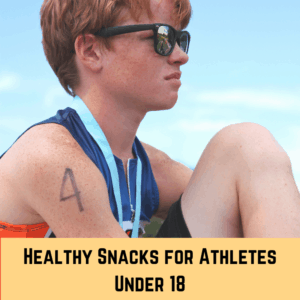Fun Facts About Iron for Young Athletes
November 2, 2022
Learn about the importance of iron for young athletes and which foods you can add to the diet to enhance overall iron intake.
Do you know the facts about iron, especially as they relate to your young athlete?
Iron is an important nutrient for any individual, no matter the age. Not only is it super important in the first two years of life, for growing child athletes, it’s also critical, especially when your child gets older, during the teenage years.
With an uptick in growth, changing eating habits, and (for girls) the onset of menstruation, iron becomes a central nutrient to watch.
Related: Read about young infants and the importance of iron in their diet for brain growth and intellectual development.
In this article, you will learn:
- The role of iron in your growing child
- The signs of iron deficiency
- The sources of foods with iron so you can support your child, athlete or not
- Iron facts for athletes
What are the Symptoms of Iron Deficiency in Athletes?
The symptoms of iron deficiency include fatigue, pallor (paleness), weakness, chest pain, dizziness, and cold hands and feet.
I’ve noticed that some kids will demonstrate the symptoms of iron depletion, yet when they are tested for anemia, everything looks normal (or within normal range).
If there are symptoms, such as fatigue or difficulty sleeping, I’m curious about the typical eating patterns. Especially looking to see whether there are iron rich foods in the diet.
I’m outlining the facts about iron for athletes below so you can pick up on any signs of deficiency early.
If you see or suspect iron deficiency or iron deficiency anemia, contact your doctor for an evaluation.
Related: How to Fix Iron Deficiency in Your Toddler or Child
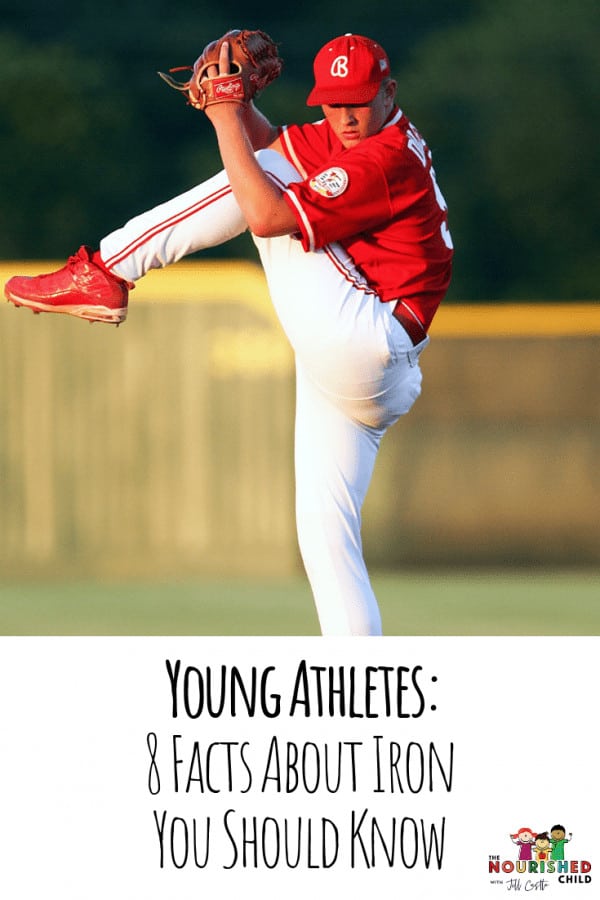
8 Surprising and Fun Facts about Iron for Young Athletes
Young athletes may struggle with a sense of extreme tiredness or fatigue. Of course, this could be caused by not getting enough sleep, but it might be due to inadequate dietary intake, muscle breakdown, or monthly menstruation.
Understanding some of the basic facts about iron will help you assess what’s going on with your child.
1. Two Types of Iron Content in Food
I’m starting with one of the most basic facts about iron: Not all foods are equal.
Foods that come from animals and fish have heme iron, which is easily absorbed and used in the body after it’s eaten.
Non-heme iron comes from plant foods like spinach. It is not as readily absorbed by the body and needs a vitamin C “helper,” such as red pepper or citrus fruit.
If your teen athlete is vegetarian or vegan, you’ll need to pay attention to the iron in her diet and include vitamin C sources on the menu.
[Want some iron-rich recipes? Check out my Beef in a Crockpot and Spinach Pizza Rolls.]
2. Iron Transports Oxygen in the Body
Iron is so important for athletes! Muscles need oxygen to function properly.
Iron carries oxygen to the cells of the muscles and organs.
Without adequate iron in the body, muscles may not get enough oxygen. This can lead to fatigue, a lowered aerobic capacity for exercise, and poor athletic performance.
3. Iron Requirements are Higher During the Teen Years
The period of childhood and adolescence are high demand times for iron (fun fact about iron).
Between the ages of 14 and 18 years, iron needs increase to accommodate your athlete’s rapid growth spurt and her expanding blood supply.
Females almost double their iron requirement to cover the iron losses that occur with menstruation.
You may be surprised to learn that iron is even lost in sweat!
[Read: 7 Ways to Support the Teen Growth Spurt]
4. Iron Deficiency and Iron Deficiency Anemia in Athletes are Two Different Things
Iron deficiency means that the athlete diet is low in iron.
Animal sources such as meats, poultry, fish and plant-based (non-heme) foods with iron like beans, tofu, and dark leafy vegetables are not eaten frequently, or they are consumed in inadequate amounts on a regular basis.
Prolonged low iron in the diet may lead to iron deficiency anemia.
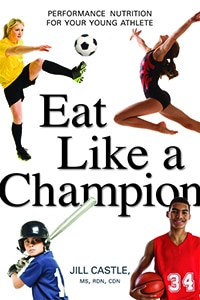
5. Iron Deficiency Anemia Equals Fatigue in Teenage Athletes
Fatigue is a common symptom of iron deficiency anemia.
In teen athletes, fatigue from anemia versus fatigue from hard training may be difficult to tease out.
In the growing athlete, fatigue from anemia versus fatigue from hard training may be difficult to tease out. #eatlikeachampion #youngathlete Click To TweetOther symptoms can show up too, such as pale skin, low body temperature and feeling cold, lightheadedness, shortness of breath, restless leg syndrome (an urge to move legs due to discomfort, often occurring at night, something that has been studied in children with ADHD), and chronic infections and colds.
6. Athletes are at Greater Risk for Iron Deficiency Anemia
During exercise, blood cells break down. One study measured hemoglobin (an indicator of iron stores in the blood) before and after racing in a small group of collegiate swimmers.
Researchers showed that 10% of the swimmers experienced lower levels of hemoglobin after racing.
They called this “swimmers anemia” and found it correlated with the length of time spent swimming.
Other studies in adults have suggested reduced athletic performance when poor iron status (but not anemia) exists.
I pay extra attention to the diet and eating habits of young athletes who fall into the following categories because they are at higher risk for iron deficiency anemia:
- athletes in a growth spurt
- athletes who are picky eaters
- athletes who are vegetarian
- athletes who diet or skip meals
- athletes who have an unhealthy diet
- teen females
Female teen athletes are particularly sensitive to anemia due to growth and menstruation.
7. If Your Child Has Anemia, You Won’t Fix it with Food
It has been estimated that up to 9% of female teens have iron deficiency anemia, despite screening and prevention efforts, according to an online article in UptoDate.
The rates among US children are thought to be between 3 and 7 percent.
A recent study, however, shows that iron deficiency in young infants (between 6 and 12 months) has more than doubled since 2002, approaching levels of 18% currently, indicating a potential uptick in anemia rates starting at a young age.
If your athlete has developed anemia, she will need an iron supplement to replenish her iron stores.
This intervention should be done with a healthcare professional, as too much iron can have negative health consequences.
Additionally, you should work to improve the iron content of your child’s diet. This will ensure adequate iron supply from food after supplementation has been discontinued.
8. Multivitamins with Iron are Not Sufficient for a Real Iron Deficiency
While multivitamins are an option for the child and teen who is generally healthy, they don’t have the proper iron content to correct iron deficiency anemia.
Typically, a child or teen with iron deficiency anemia will need an iron repletion regimen. Some cases will require extended treatment to ensure iron stores are optimal and the symptoms of deficiency are resolved.
Always work with a healthcare professional to guide iron therapy for anemia.
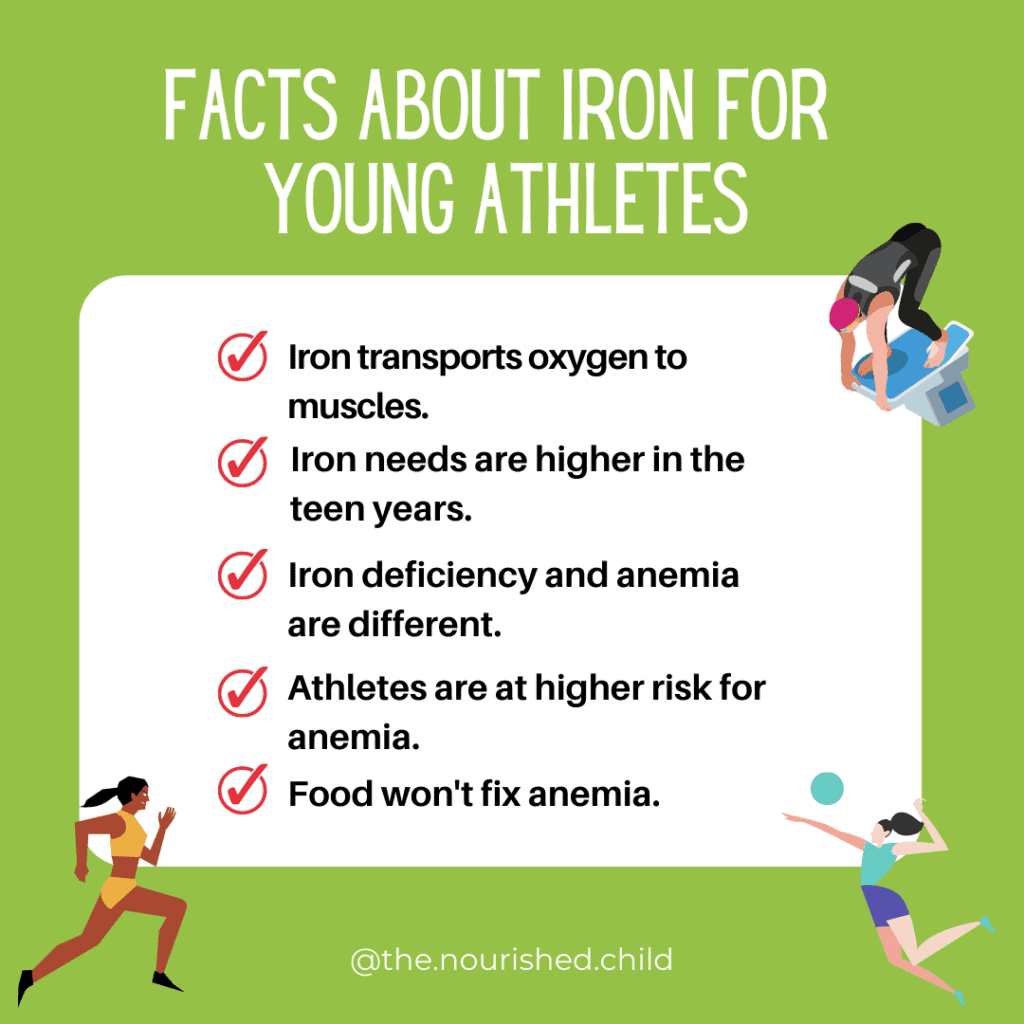
How Much Iron Does a Child Need a Day?
These are the DRI (Dietary Reference Intakes):
1-3 years: 7 mg
4-8 years: 10 mg
9-13 years: 8 mg
14-18 years: 15 mg (girls)
11 mg (boys)
How to Get More Iron in the Diet
If your young athlete needs to improve their iron consumption from natural sources of iron, add the following foods to their daily intake.
Remember to include a source of vitamin C to the meal or snack, like citrus fruit, broccoli or tomatoes, if your athlete is eating plant sources of iron.
Animal Sources of Iron (Heme iron) | Plant Sources of Iron (Non-heme iron) |
Chicken liver, beef chuck, ground beef, turkey (dark meat), canned tuna, chicken (dark meat) | 100% iron-fortified cereals, instant oatmeal, soybeans, black beans, pinto beans, raisins, spinach, white and whole wheat bread |
Want More Help for Your Young Athlete?
I hope you have a better understanding of why iron matters for kids and teens, especially our athletes! Want more information about nutrition for young athletes? I’ve got several options for you!
My Program: Eat Like a Champion (for young athletes, parents and coaches)
Read: The Best Iron Rich Foods for Teens.
Subscribe to The Nourished Child podcast! I have several episodes devoted to the young athlete.
Get the big picture and read The Young Athlete: Ultimate Guide to Nutrition.
This post was updated in November, 2022.

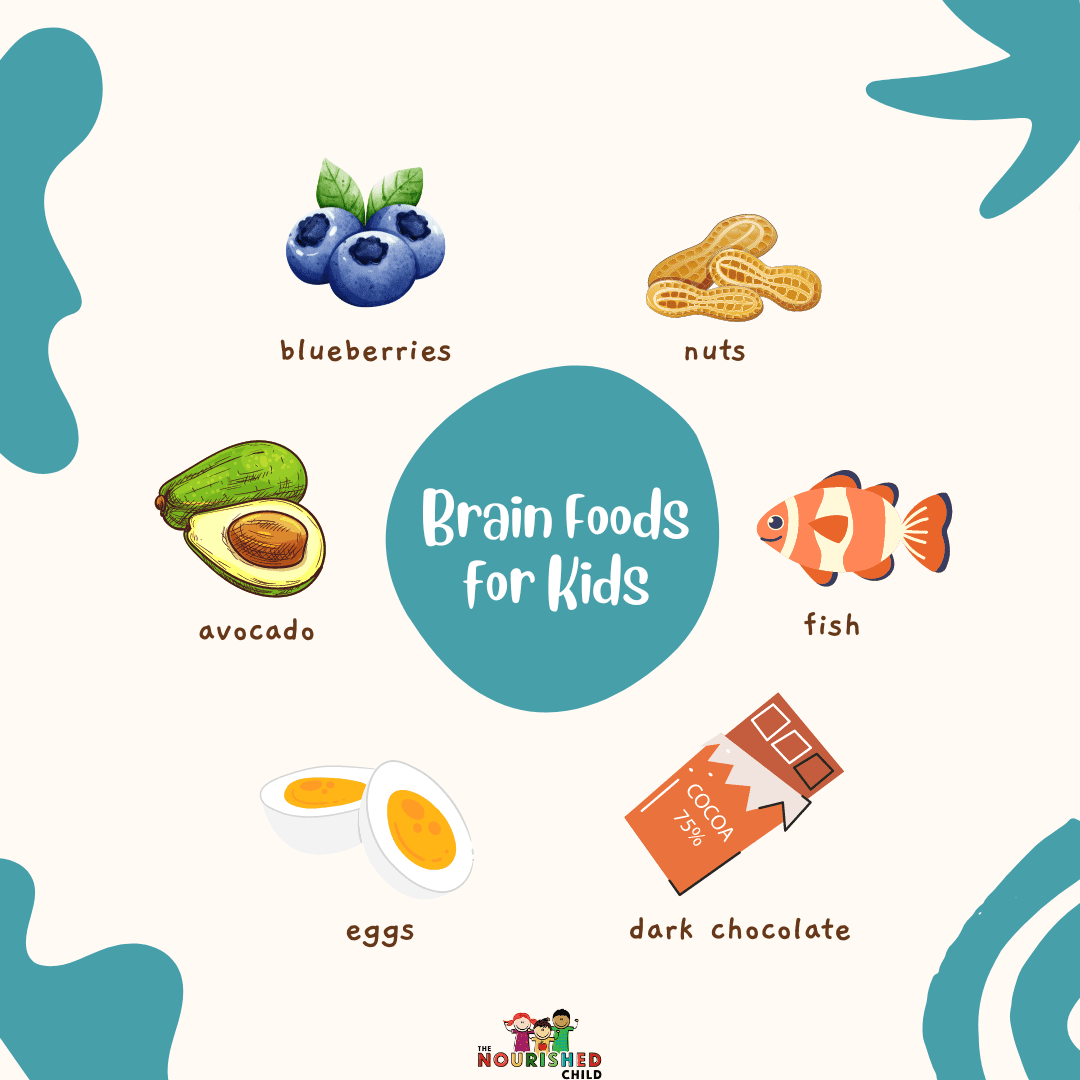
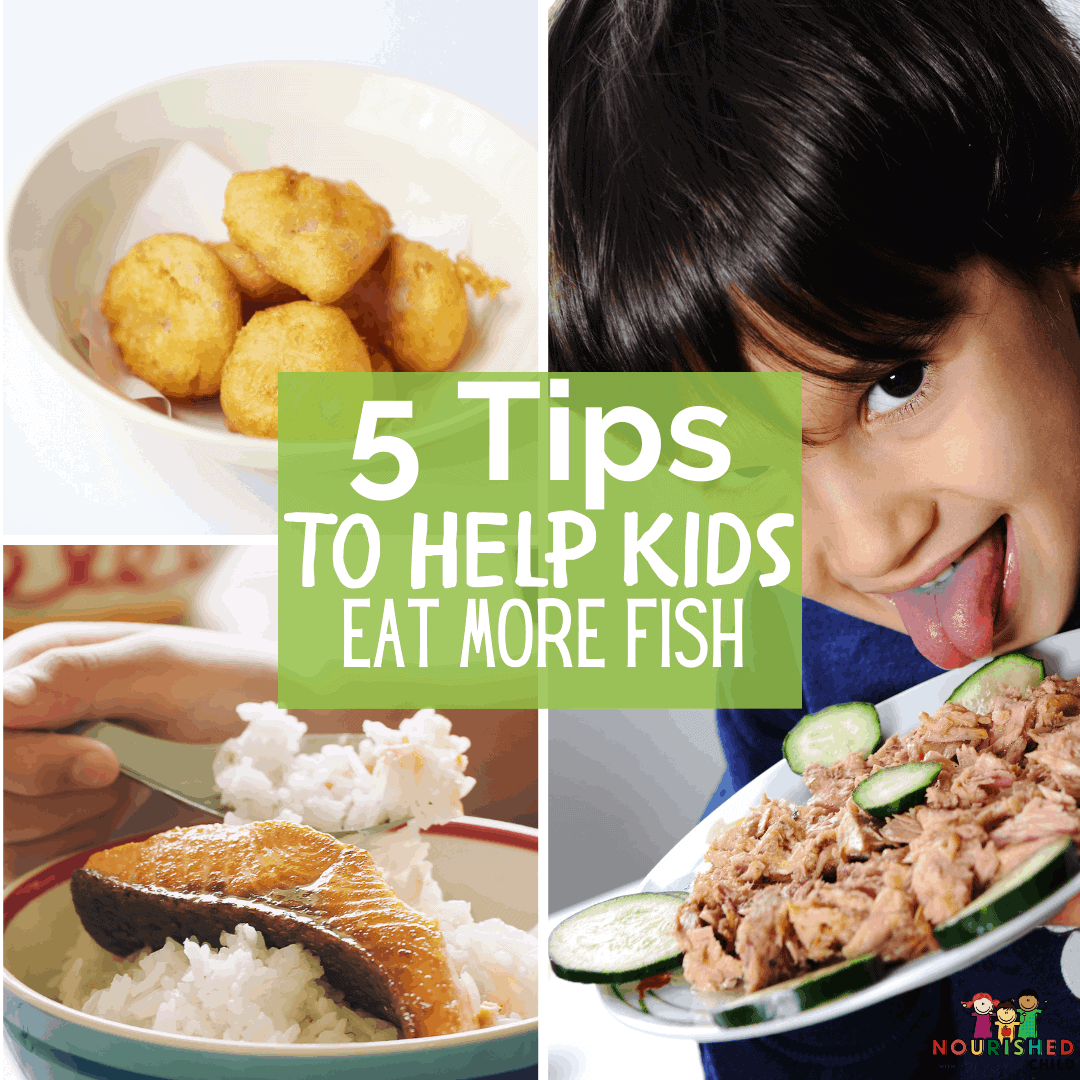
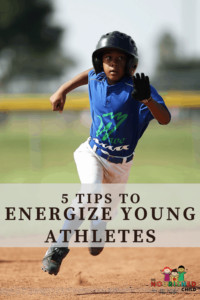
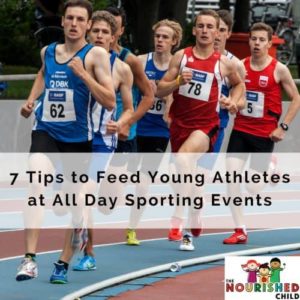
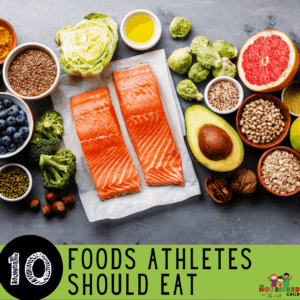
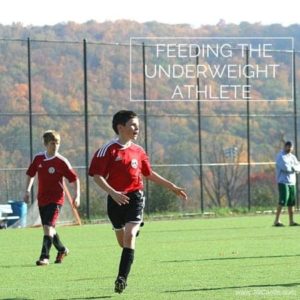
![Game Day Granola [Recipe]](https://thenourishedchild.com/wp-content/uploads/2015/11/Game-Day-Granola-e1447270901887-300x300.jpg)
